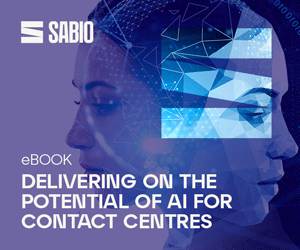Increasingly, organisations are using analytics to better understand what customers think about their products, services, policies, and service representatives.
Analytics offers deep insight into customer behaviour and opinions – a critical step that lies at the heart of customer-centric service strategies.
When deployed as part of a workforce optimisation (WFO) solution, analytics can extend the reach of WFO beyond the contact centre, into other areas of the enterprise – including branch, remote, and back-office operations – to enhance the customer experience, drive down costs, and improve competitive advantage.
Why WFO, Why Now?
During challenging economic times, some companies may allow the bottom line to overwhelm customer service decisions.
Amid business pressures, such as fluctuating profits and staff changes, the priority around maintaining customer service levels may become compromised.
But, the fact remains that despite business pressures and lower revenue, customers expect the same high-level service.
Smart companies that value customer service in tough times will reap the reward of customer loyalty when the economy recovers – making them a special breed that have identified the customer experience to be more important now than ever.
WFO enables organisations to provide smarter customer service, balancing cost reduction with customer centricity.
It combines software, services and supporting businesses processes to help global organisations improve customer service operations across the enterprise – from customer interactions in the contact centre to underlying back-office business procedures.
WFO captures information on workforce performance, customer interactions, service levels, and customer loyalty – which in turn helps both the front- and back-office departments influence processes, adjust staffing, and make other decisions that can impact the cost and quality of the customer experience.
Analytics Versus Reporting
Although many contact centres believe they already employ analytics in their operational processes and decision making, they often are confusing reporting with analytics.
Their confusion is understandable, since analytics requires good, abundant data, and contact centres typically are awash in data – and reports.
But reports don’t constitute analytics, even when you spend time “analysing” them. Reports – including ad hoc reports – focus on what has happened.
Drill-down capabilities (often confused with analytics) enable users to pinpoint where problems actually occurred (past tense). Alerts are a refinement that moves reporting from an historical perspective toward a real-time perspective.
Instead of focusing on what has happened, analytics focus on why. Why are customers calling and emailing? Why are they defecting?
Why does demand in the contact centre spike? Why is the average handle time what it is? Why do individuals in classes led by different instructors have dramatically different performance levels? These are the essential questions that analytics can answer.
But analytics can also address other types of questions, and they are equally important. For example, how long will customers wait in queue before becoming upset? Are calls scored as being “high” in quality actually
perceived that way by our customers? How should we respond to trends that we’ve discovered in our data? How can we get the best possible outcome based on our current resources?
In the contact centre, speech analytics, data analytics, and customer feedback management are potential standalone applications.
However, just as the core functions of workforce optimisation benefit from deep integration, the analytic solutions benefit from integrations and synergies with each other.
Analytics-Driven Customer Service
Speech analytics, data analytics and customer feedback surveys bring forth pivotal “moment of truth” interactions that can shape customer relationships and provide valuable insight for strengthening or recovering those at risk.
Declines in consumer spending should stand as reinforcement for companies to reinvest in their existing pool of customers.
A valued customer today remains a source of repeat revenue tomorrow. Analytics-driven customer service can help make this goal a reality.
Designed to help organisations develop a more thorough understanding of customers’ wants and needs, these analytics tools not only help optimise customer interactions but also promote lasting and profitable customer relationships.
On one hand, there is speech analytics. It combines structured and unstructured data, analysing and identifying key circumstances that may positively or negatively impact business performance.
Add to that data analytics, which identifies anomalies that could be negatively impacting performance. Complementing the effort are customer surveys that capture direct customer feedback on products, processes and staff performance. Together, the three help organisations make better decisions faster.
Speech Analytics
Speech analytics software can automatically categorise and analyse customer interaction content to reveal the root causes of customer perceptions, business outcomes and high call volumes.
It can identify competitive threats and market opportunities, and surface trends that might not otherwise be detected without listening to thousands of contact centre interactions.
The solution starts by looking at and evaluating a subset of particular calls to dive deeper and identify possible root-cause issues. For example, a contact centre manager may search for all calls that received a poor customer feedback score.
By mining all of these data sources and presenting the results in a way that immediately prioritises what has the most impact, organisations can quickly take action to act on and maximise opportunities and proactively address negative trends.
Data Analytics
Data Analytics mines massive amounts of data found in calls, speech analytics, quality scores, screen events, CTI data and more.
This information reveals specific scenarios that can help or hurt overall contact centre performance. It estimates potential ROI, as it relates back to cost savings and operational efficiencies, before action is taken.
For example, an organisation used data analytics to identify that most of its “newer” agents were scoring low on calls relating to new product promotions and, as a result, were decreasing quality scores by six per cent.
With this information, the company decided to retrain the agents on how to present the product offers to customers more effectively.
By examining contact centre metrics, companies can find the factors that can have the greatest impact on the bottom line, and then make necessary improvements.
Customer Feedback Surveys
Customer feedback surveys engage customers immediately after their interactions with an agent. More than just a survey, it enables organisations to gather data on products/staff performance, and customer loyalty/satisfaction levels in real time.
As a result, contact centres can identify and measure the drivers of customer behaviour, along with specific areas for improvement.
Because these surveys are intelligent, context-based and timely, they engage customers and deliver response rates far greater than those obtained through traditional, one size-fits-all questionnaires.
As a result, organisations can move beyond mere sampling to capture meaningful data, even with large numbers of customers and multiple sites.
Analytics-Driven Training
Content from speech and data analytics and customer feedback surveys can serve as content in eLearning and training sessions to help customer service agents improve their skills and proficiencies.
This insight can also be fed into other less customer-facing areas of the business that help shape the customer experience – such as back-office operations that handle order fulfilment and claims processing.
Leveraging analytical tools, organisations can maximise information flow across every department while minimising the total cost of ownership.
Customer-Centric Analytics
Customer interaction analytics have also helped shift the emphasis of quality management from what the employees are doing to what the customers are doing.
What are they saying? Are they satisfied? What can be done to fix problems? Are common calls related to larger trends? The solution can sort through thousands of interactions and extract the necessary information quickly.
Going beyond the immediate and typical customer touch points, such as the contact centre, marketing, financial and product departments can also leverage the analytics intelligence to help improve and adapt company promotions, billing statements and product/service offerings.
Written by: Rob Wint, Marketing Director, Verint
For more on workforce optimisation, read these articles next:
- Workforce Optimisation: 11 Ways to Improve Your Contact Centre Schedules
- Workforce Management vs Workforce Optimization – What’s the Difference?
- What Is Workforce Management (WFM) in BPO?
Author: Jonty Pearce
Reviewed by: Hannah Swankie
Published On: 14th Mar 2010 - Last modified: 10th Sep 2025
Read more about - Technology















